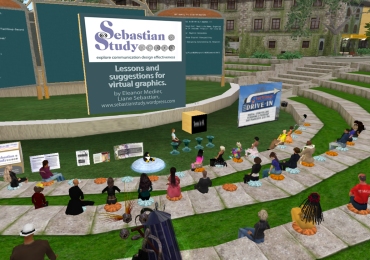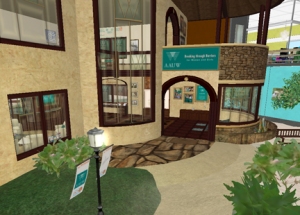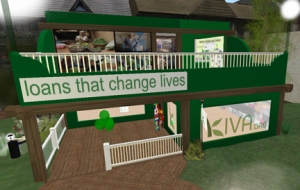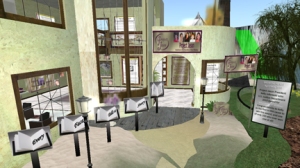
Although Second Life is now about five years old, the jury is out on its penetration and impact. As a new platform, I am now examining its 80 resident nonprofit organizations. It also opens this Study up more into the national arena.
Second Life is at a crisis point. The early enthusiasts are exhausted and impatient with its acceptance level. New users easily get frustrated and overwhelmed. Yet Nonprofit Commons (acting as an information portal) receives over 1600 visitors a month. Second Life combines websites, blogs, publications, video, social media, and resources all in one place with the added feature of fun. Such great functionality means the interface has a high learning-curve that the world’s designers prioritize as their greatest challenge to solve.
What does this mean for nonprofits? As a professional communicator, I believe that virtual environments are the future of presentation, education, publication, events, and conferences. Virtual advantages offer a new landscape of opportunity:
 1. Development is inexpensive. Granted, development is time-consuming, but it is free to register and partake of activities.
1. Development is inexpensive. Granted, development is time-consuming, but it is free to register and partake of activities.
 2. A donation system allows organizations a vehicle for increasing revenue. A virtual bank handles transactions and can translate SL money into RL (real life) money. Showing how revenue is used is easier than in any other media.
2. A donation system allows organizations a vehicle for increasing revenue. A virtual bank handles transactions and can translate SL money into RL (real life) money. Showing how revenue is used is easier than in any other media.
 3. Travel is possible both in time and in space. Historical simulations (sims) allow creative and meaningful settings. Shared experiences as tours and in imaginative settings add to the overall enjoyment of participation.
3. Travel is possible both in time and in space. Historical simulations (sims) allow creative and meaningful settings. Shared experiences as tours and in imaginative settings add to the overall enjoyment of participation.
 4. Ambient experience of prospects and members can be magnified exponentially. Because all other media feed in and influence presentation and graphics, the user interaction gives an unparalled access to serving them. Libraries have staff that can help the “newbies” get set up and situated—individually and with a high level of customer service. Docents conduct tours, give lectures, run discussion groups, and teach classes.
4. Ambient experience of prospects and members can be magnified exponentially. Because all other media feed in and influence presentation and graphics, the user interaction gives an unparalled access to serving them. Libraries have staff that can help the “newbies” get set up and situated—individually and with a high level of customer service. Docents conduct tours, give lectures, run discussion groups, and teach classes.
 5. Education is exploding. Discussion groups and classes are growing and cover everything from learning software to support groups to expeditions to exhibitions. Pioneering universities ave curricula and events with a greater geographic reach than real life (RL) venue.
5. Education is exploding. Discussion groups and classes are growing and cover everything from learning software to support groups to expeditions to exhibitions. Pioneering universities ave curricula and events with a greater geographic reach than real life (RL) venue.
 6. Everyone is appealing. Because the user creates an avatar, it is pure self-expression. Second Life’s status report indicates that it isn’t a place to create a fantasy as much as it is an idealized sense of self. For example, I am a younger and thinner version of myself, dress a little more adventurously, and always have clean clothes! The people that I meet often post their RL photo and their avatar tends to be a slightly more fanciful depiction of themselves—demonstrating individualized taste when practicality isn’t an issue.
6. Everyone is appealing. Because the user creates an avatar, it is pure self-expression. Second Life’s status report indicates that it isn’t a place to create a fantasy as much as it is an idealized sense of self. For example, I am a younger and thinner version of myself, dress a little more adventurously, and always have clean clothes! The people that I meet often post their RL photo and their avatar tends to be a slightly more fanciful depiction of themselves—demonstrating individualized taste when practicality isn’t an issue.
 7. Real money can be made. Donations to organizations are real. Bookstores can offer presentations and events that can attract a national audience versus a regional one, without a cost for travel. Artwork can be shown in low-resolution and sold to be shipped. Memberships can be signed with growing customization.
7. Real money can be made. Donations to organizations are real. Bookstores can offer presentations and events that can attract a national audience versus a regional one, without a cost for travel. Artwork can be shown in low-resolution and sold to be shipped. Memberships can be signed with growing customization.
 8. New ideas can be tested before investing resources. An event can evaluate interest levels, surveys can reach a known constituency, and niches can best target. If there are several ideas, variations are easy to niche.
8. New ideas can be tested before investing resources. An event can evaluate interest levels, surveys can reach a known constituency, and niches can best target. If there are several ideas, variations are easy to niche.
 9. Accessible for discovering who is doing what. There is an endless amount of resources, tutorials, instructions, and self-seminars. Then, those who authored these resources can be reached easily and they are surprisingly helpful!
9. Accessible for discovering who is doing what. There is an endless amount of resources, tutorials, instructions, and self-seminars. Then, those who authored these resources can be reached easily and they are surprisingly helpful!
 10. All the graphics needed in RL are necessary, plus there are new design components required. Now, organizations actually have a PLACE that is a room or a building. Architecture and interior design becomes necessary on an entirely new level. Posters, instructions, and information presentations also possess new dimensions. Blogs and wikis can be more useful as they augment a major presentation versus carry the information load themselves.
10. All the graphics needed in RL are necessary, plus there are new design components required. Now, organizations actually have a PLACE that is a room or a building. Architecture and interior design becomes necessary on an entirely new level. Posters, instructions, and information presentations also possess new dimensions. Blogs and wikis can be more useful as they augment a major presentation versus carry the information load themselves.
 11. Second Life is not the only virtual realty world. There is growing competition. How these platforms complement and integrate versus dilute and complicate remains to be seen. They will probably shake out to niche audiences which would be a shame, for it inhibits the rich cross-disciplinary cultivation happening now. My friends are a teacher in Arizona, professor in Boston, nurse in San Diego, and artist in Phoenix.
11. Second Life is not the only virtual realty world. There is growing competition. How these platforms complement and integrate versus dilute and complicate remains to be seen. They will probably shake out to niche audiences which would be a shame, for it inhibits the rich cross-disciplinary cultivation happening now. My friends are a teacher in Arizona, professor in Boston, nurse in San Diego, and artist in Phoenix.
 12. Mistakes and typos are tolerated. Everyone interacts spontaneously. Information goes up and down quickly. There is a Second Life pace that, like RL, is organic and unpredictable.
12. Mistakes and typos are tolerated. Everyone interacts spontaneously. Information goes up and down quickly. There is a Second Life pace that, like RL, is organic and unpredictable.
 13. Brevity is necessary. Those with writing skills have an advantage. But all users must learn to convey ideas in small chunks. Two sentence responses in a chat are the limit to have a good exchange.
13. Brevity is necessary. Those with writing skills have an advantage. But all users must learn to convey ideas in small chunks. Two sentence responses in a chat are the limit to have a good exchange.
 14. Presentations can be more polished. As with a website, it is easy to correct, constantly changing, and never finished.
14. Presentations can be more polished. As with a website, it is easy to correct, constantly changing, and never finished.
 15. It needs to be staffed. Beyond a webmaster, a docent is a tool to welcome, answer questions, and guide. Newbies have a new friend and are easier to pull in than through a piece of literature or a video.
15. It needs to be staffed. Beyond a webmaster, a docent is a tool to welcome, answer questions, and guide. Newbies have a new friend and are easier to pull in than through a piece of literature or a video.
 16. Social media has a greater potential for commonalitiy and understanding. For each person met, his or her name is obvious (virtual version of wearing a name tag) and a profile can be reviewed. Public forum are often filled with those hanging out wasting time (not serious potential members or colleagues), so those who get the most from the platform learn to avoid “info hubs.” Many are doing business and not interested in building a social life. Conversely, most users are interested in making friends to compare notes, travel with, and get to know in a completely safe and unthreatening setting.
16. Social media has a greater potential for commonalitiy and understanding. For each person met, his or her name is obvious (virtual version of wearing a name tag) and a profile can be reviewed. Public forum are often filled with those hanging out wasting time (not serious potential members or colleagues), so those who get the most from the platform learn to avoid “info hubs.” Many are doing business and not interested in building a social life. Conversely, most users are interested in making friends to compare notes, travel with, and get to know in a completely safe and unthreatening setting.
 17. Communication takes on new dimensions: while there is a public chat forum going on, there can be private side-conversations at the same time. This offers a way to personally attend to each attendee or visitor question while addressing the group at the same time.
17. Communication takes on new dimensions: while there is a public chat forum going on, there can be private side-conversations at the same time. This offers a way to personally attend to each attendee or visitor question while addressing the group at the same time.
 18. Involvement can be easily phased—from having a sign or a kiosk of links, to running discussion groups, to holding events (of any scope), to renting a storefront, to hosting an entire island, the possibilities are greater than in RL where physical barriers slow down or limit accessibility. All users begin by being a visitor, discover a new pace to interactions, and develop a personal purpose.
18. Involvement can be easily phased—from having a sign or a kiosk of links, to running discussion groups, to holding events (of any scope), to renting a storefront, to hosting an entire island, the possibilities are greater than in RL where physical barriers slow down or limit accessibility. All users begin by being a visitor, discover a new pace to interactions, and develop a personal purpose.
 19. A new discipline becomes necessary. Second Life is seductive. Wasting time flying around the Roman Forum is too much fun! The busiest time is in the evening when users all over the country are winding down their work days. So late nights having conversations with fascinating people happens frequently. It is especially exciting to meet professional counterparts in other places. So deciding before-hand how much time there is to spend can help. So can a specific Things to Do List as a concrete plan to keep from wandering.
19. A new discipline becomes necessary. Second Life is seductive. Wasting time flying around the Roman Forum is too much fun! The busiest time is in the evening when users all over the country are winding down their work days. So late nights having conversations with fascinating people happens frequently. It is especially exciting to meet professional counterparts in other places. So deciding before-hand how much time there is to spend can help. So can a specific Things to Do List as a concrete plan to keep from wandering.
 20. Accessibility is redefined. In RL, voice mail and e-mail have added new insulations between people. To cold call in sales is considered spam and inhibits reputations and sales methods. But in SL, contacting anyone is easy. That will have to change, similarly to how blogs are struggling to be responsive as popularity and demand increase (for those that are successful).
20. Accessibility is redefined. In RL, voice mail and e-mail have added new insulations between people. To cold call in sales is considered spam and inhibits reputations and sales methods. But in SL, contacting anyone is easy. That will have to change, similarly to how blogs are struggling to be responsive as popularity and demand increase (for those that are successful).
 21. Collaboration and connection transform competition. Defining niches becomes mandatory. SIM adventures allow organizations to take members on journeys not possible in RL. Those with disabilities can find a more even playing field and new assistance. Those separated physically can still exert significant influence and assistance.
21. Collaboration and connection transform competition. Defining niches becomes mandatory. SIM adventures allow organizations to take members on journeys not possible in RL. Those with disabilities can find a more even playing field and new assistance. Those separated physically can still exert significant influence and assistance.
Excited about the possibilities, I will embark further on understanding how these pioneering nonprofits are expanding through Second Life opportunities. It requires that I revisit the criteria I have been using for evaluating graphics. Because all the traditional components of logo, banner, site, publications are present, I am excited to learn more about environments, video, and interactivity. If you wish to find me in Second Life, check out the Nonprofit Commons—I’ll be there a lot for the next few weeks. For the more adventurous, join me in the Chicago Roaring 20s SIM where you’ll find my entrepreneurialism in new expression!

The Sebastian Study: Midwest Nonprofits is completed in this blog. If you wish to know if your organization was considered, please visit www.wofw.com and contact me; I will be happy to share the review ranking with you.
The Sebastian Study: Second Life Nonprofits now begins, so watch for reviews, overviews, and experiences shared in upcoming posts. The ten best presentations will be analyzed, the almost-greats critiqued, and new conclusions drawn to help evolve effectiveness.




 1. Project parameters are not completely formulated when starting a project, especially when deadline is an issue. When you aren’t paying for the designer’s time, it is easy to be too casual in gaining initial consensus, identifying expectations, and defining the decision-making process. Rather, speculative work falls lower on the priority list for busy executives. To impress decision-makers into attentiveness, put money on the table. To begin a project without an agreed upon plan is to conduct a time-consuming experiment that falls apart through disorganization.
1. Project parameters are not completely formulated when starting a project, especially when deadline is an issue. When you aren’t paying for the designer’s time, it is easy to be too casual in gaining initial consensus, identifying expectations, and defining the decision-making process. Rather, speculative work falls lower on the priority list for busy executives. To impress decision-makers into attentiveness, put money on the table. To begin a project without an agreed upon plan is to conduct a time-consuming experiment that falls apart through disorganization.



